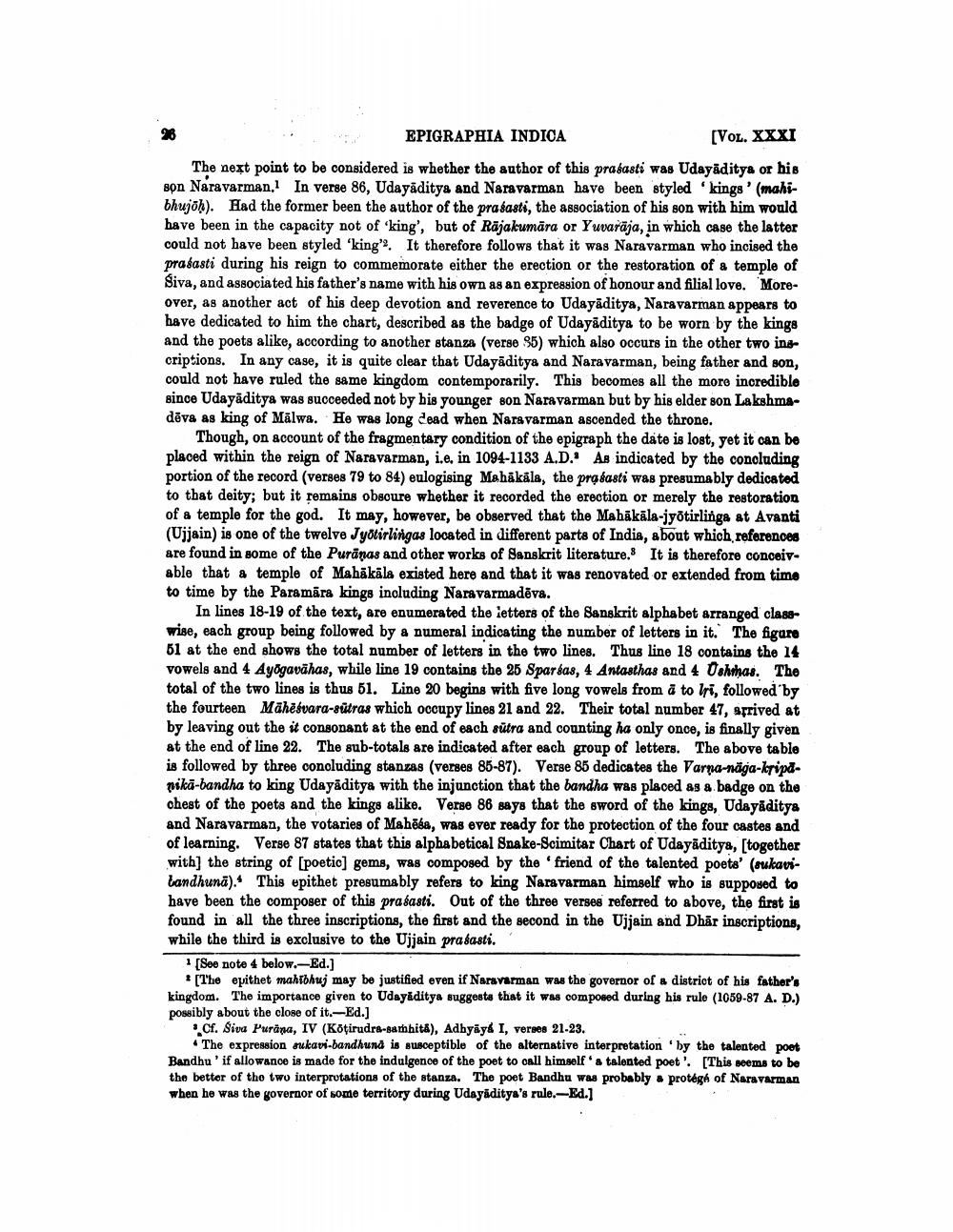________________
EPIGRAPHIA INDICA
[VOL. XXXI
The next point to be considered is whether the author of this prasasti was Udayāditya or his son Naravarman. In verse 86, Udayaditya and Naravarman have been styled 'kings' (mahibhujõh). Had the former been the author of the prasasti, the association of his son with him would have been in the capacity not of 'king', but of Rajakumara or Yuvarāja, in which case the latter could not have been styled 'king'. It therefore follows that it was Naravarman who incised the prasasti during his reign to commemorate either the erection or the restoration of a temple of Siva, and associated his father's name with his own as an expression of honour and filial love. Moreover, as another act of his deep devotion and reverence to Udayāditya, Naravarman appears to have dedicated to him the chart, described as the badge of Udayaditya to be worn by the kinge and the poets alike, according to another stanza (verse 55) which also occurs in the other two inscriptions. In any case, it is quite clear that Udayāditya and Naravarman, being father and son, could not have ruled the same kingdom contemporarily. This becomes all the more incredible since Udayaditya was succeeded not by his younger son Naravarman but by his elder son Lakshmadēva as king of Malwa. He was long dead when Naravarman ascended the throne.
Though, on account of the fragmentary condition of the epigraph the date is lost, yet it can be placed within the reign of Naravarman, i.e. in 1094-1133 A.D.: As indicated by the concluding portion of the record (verses 79 to 84) eulogising Mehākāla, the prošasti was presumably dedicated to that deity; but it remains obscure whether it recorded the erection or merely the restoration of a temple for the god. It may, however, be observed that the Mabākāla-jyotirlinga at Avanti (Ujjain) is one of the twelve Jyotirlingas located in different parts of India, about which references are found in some of the Puranas and other works of Sanskrit literature. It is therefore conceivable that a temple of Mahäkäla existed here and that it was renovated or extended from timo to time by the Paramära kings including Naravarmadēva.
In lines 18-19 of the text, are enumerated the letters of the Sanskrit alphabet arranged classwise, each group being followed by a numeral indicating the number of letters in it. The figure 61 at the end shows the total number of letters in the two lines. Thus line 18 contains the 14 vowels and 4 Ayðgavähas, while line 19 contains the 25 Sparbas, 4 Antasthas and 4 Oshthas. The total of the two lines is thus 51. Line 20 begins with five long vowels from a to Iri, followed by the fourteen Māhèsvara-sūtras which occupy lines 21 and 22. Their total number 47, sprived at by leaving out the it consonant at the end of each sutra and counting ha only once, is finally given at the end of line 22. The sub-totals are indicated after each group of letters. The above table is followed by three concluding stanzas (verses 85-87). Verse 85 dedicates the Varna-naga-kripd. pika-bandha to king Udayāditya with the injunction that the bandha was placed as a badge on the chest of the poets and the kings alike. Verse 86 says that the sword of the kings, Udayaditya and Naravarman, the votaries of Mahēka, was ever ready for the protection of the four castes and of learning. Verse 87 states that this alphabetical Snake-Scimitar Chart of Udayaditya, [together with] the string of [poetic) gems, was composed by the friend of the talented poets' (sukavibandhunā). This upithet presumably refers to king Naravarman himself who is supposed to have been the composer of this prasasti. Out of the three verses referred to above, the first is found in all the three inscriptions, the first and the second in the Ujjain and Dhār inscriptions, while the third is exclusive to the Ujjain prasasti.
[See note 4 below.-Ed.)
*[The epithet mahfohuj may be justified even if Naravarman was the governor of a district of his father's kingdom. The importance given to Udayaditya suggests that it was composed during his rule (1059-87 A. D.) possibly about the close of it.-Ed.)
cf. Siva Purana, IV (Kotirudra-samhita), Adhyay& I, verres 21-23.
4 The expression eukavi-bandhund is susceptible of the alternative interpretation by the talented poet Bandhu' if allowance is made for the indulgence of the poet to call himself a talented poet'. [This seems to be the better of the two interpretations of the stanza. The poet Bandhu was probably a protege of Naravarman when he was the governor of some territory during Udayaditya's rule.--Ed.]




